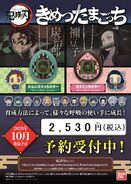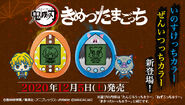| ← Evatchi | Demon Slayer Tamagotchi | Extellatchi → |
|---|---|---|
| This article is about a Japanese Tamagotchi release. | ||
| ← Hello Kitty Tamagotchi | Demon Slayer Tamagotchi | Evatchi → |
|---|---|---|
| This article is about an English Tamagotchi release. | ||
The Demon Slayer Tamagotchi (known as the Kimetsu Tamagotchi (きめつたまごっち) in Japan) (귀멸의다마고치 in Korean) is a licensed Tamagotchi Nano model based on the anime and manga franchise Demon Slayer: Kimetsu no Yaiba. It was released in Japan in October 2020 (correlating with the theatrical release of Kimetsu no Yaiba: The Movie - Mugen Train).
It was released in the United States on January 1, 2021. It retains its original Japanese design, packaging and programming, with English instructions available on Bandai's official site.
A second version, called the Hashira Gathering Version (柱集結版) (주집결판), was announced on October 30th and is set to be released in March 2021 in Japan and August 1, 2021 in the United States.
Design
The Demon Slayer Tamagotchi returns to using the original ball and chain from the previous Tamagotchi Nano models, after both the Pac-Man Tamagotchi and Evatchi used different styles.
Each shell design is based on the robes worn by characters from the series. For the original version, the four initial designs are based on the robes of the four lead characters, while the Amazon exclusive shell is inspired by the standard uniform of the Demon Slayer Corps. The Hashira Gathering Version's shells are based on the robes worn by the nine Hashira.
Background
Demon Slayer: Kimetsu no Yaiba is a manga and anime franchise released in Japan in 2016. Taking place place in Taishō-era Japan, the story follows Tanjiro Kamado and his sister Nezuko Kamado as they seek a cure to Nezuko's demon curse. Tanjiro and Nezuko become entangled in the affairs of a secret society, known as the Demon Slayer Corps, that have been waging a secret war against demons for centuries. On the Demon Slayer Tamagotchi, the user is tasked with caring for and training a new member of the Demon Slayer Corps.
Functions
Birth and Growth
After setting the clock, the screen will show the user's Demon Slayer passing the Final Section and joining the Demon Slayer Corps. The Demon Slayer starts off as Mizunoto, which is a generic character not based off any character from the Demon Slayer series, but merely associated with the rank of the same name. It will evolve after 24 hours, and may become either Kinoe, which is another generic character based off a similar idea, or a named character based off a character from the series. Kinoe will evolve again after a further 24 hours. Evolutions are based on the quality of care it is given throughout its life, what training games are played, and how many demons it has defeated.
Buttons
There are no on-screen icons, and therefore all information is conveyed through the screen and buttons. The Demon Slayer is cared for by filling its meters; it has Hungry and Happy meters, each consisting of four units, which are both empty when the Demon Slayer is born. If either becomes empty, it will call for attention to fill them.
If the Demon Slayer needs something, the user can press the C button for an animation to see what it needs. If the Demon Slayer looks angry, it's hungry; if it sulks, it's unhappy. If its Hungry and Happy meters are not empty but the Happy meter is not full, it will play a simple happy animation. If the Happy meter is completely full and the Hungry meter is not empty, the screen will either show the Demon Slayer's current rank (in the initial growth stages) or perform a Close Up (after becoming a named character).
Pressing the A button opens the main menu, with the options to feed or to play the training games. The meal option (onigiri) fills one Hungry unit, and will refuse to eat anymore once the meter is full. The snack (green tea) fills one Happy unit, and can be fed even when the Happy meter is full. The A button is also used to open the lights on and off menu when the Demon Slayer has fallen asleep.
Menu selections are notably represented solely by images rather than words in this release.
Training Games
There are three training games, each influencing which evolution the Demon Slayer will become. Completing a game will raise the Happy meter by 1, while playing a perfect game will raise the Happy meter by 2.
- Splitting Stones: A sword will appear waving over a stone. The user must press the A or B button when the sword is lined up at the center of the stone to cut it in half. Pressing too early or too late counts as a failure. The stone must be cut five times for a perfect game.
- Gourd Breaking: The user's Demon Slayer will appear standing next to a giant gourd. The user will have 15 seconds to press the A button as much as they can. If A is pressed more than 10 times, the Demon Slayer will break the gourd.
- Medicated Water: Kanao Tsuyuri will appear with two cups, and letters will appear to the top left. The user must press the corresponding buttons (A or B, once or twice) in time. Failing to respond in time, or pressing the wrong, button, will get the Demon Slayer splashed with medicated water. The user must successfully respond at least once to win the game, and five times for a perfect game.
Missions
Throughout the day, a Kasugai Crow or Chuntaro will bring a mission, and a demon will appear. The user must press the A button to make their Demon Slayer attack the demon and drive it away. There are four possible demons that can appear, and the demon will gradually take over the screen the longer the user takes to respond. If the user fails to respond entirely, the Demon Slayer will become injured.
Demons attack more frequently at night, and they can't be banished once the Demon Slayer has fallen asleep.
Daily Reports
Every hour, normally at XX:30, a Kasugai Crow will appear to show animations of different events, based on moments from the anime and manga. Pressing any button will trigger the animation to end, with some showing an additional screen before closing. The animations appear daily, and some are different between the two versions. This feature is taken from the Evatchi.
Injury and Death
If the user severely neglects the Demon Slayer, or allows a demon to persist on the screen for too long, the Demon Slayer will become injured, portrayed by it lying in a bed and sulking. Pressing the A button multiple times will eventually heal it. If the Demon Slayer stays injured for too long, or gets injured many times, it will die, shown by the Kakushi appearing the clean up the remains. Pressing the A and C buttons together will summon a new Demon Slayer.
Gallery
Videos
Trivia
- The Demon Slayer Tamagotchi marks the first of several things:
- This is the first Tamagotchi to be released in the United States with its original, untranslated Japanese programming. Instructions translated to English are available on Bandai's website.
- All of the navigational menu screens are portrayed with images instead of text, similar to the Pac-Man Tamagotchi and Hello Kitty Tamagotchi, making this the first Japanese Tamagotchi Nano model to feature this.
- This is the first Tamagotchi model to be released in the USA without changing the pressure tab on the battery panel to a screw.
- The games featured on the Demon Slayer Tamagotchi all originate from previous Tamagotchi Nano models:
- The Splitting Stones game uses the same programming as the Evatchi's Targeting game.
- The Gourd Breaking game uses the same programming as the Pocket Usapiyo's Paint Game.
- The Medicated Water game uses the same programming as the Eevee x Tamagotchi's Dance ♪ game.
- The Demon Slayer Tamagotchi has more shell designs than any other licensed Tamagotchi Nano model, with the original version featuring five shells, and the second version featuring nine, for a total of fourteen shells.
- This is the fourth Tamagotchi to be based on an anime and/or manga, following the Doraemontchi, the Oden-Kun Tamagotchi, and the Evatchi.





